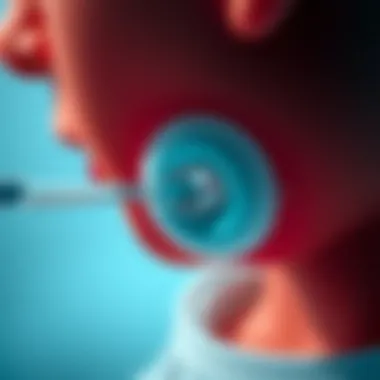Lidocaine in Treating Premature Ejaculation: A Comprehensive Review


Intro
Premature ejaculation (PE) is a widespread issue that many men face, yet it remains a topic often shrouded in stigma and misunderstanding. This sexual dysfunction can lead to significant emotional distress and relationship challenges. Despite its prevalence, treatment options have been limited, leading to the exploration of various interventions—one of which is lidocaine. Known primarily as a local anesthetic, lidocaine has been analyzed for its potential to enhance sexual performance and improve lasting power. Understanding the mechanisms by which lidocaine operates, as well as assessing its effectiveness and safety, remains crucial for both clinicians and patients.
As the conversation around sexual health evolves, incorporating pharmacological solutions into the treatment of PE has gained momentum. This article aims to bridge the gap between traditional views on premature ejaculation and contemporary treatment avenues like lidocaine. By diving into the pharmacological properties of lidocaine, we will uncover how it might address some of the root causes of PE.
Throughout this article, we will examine how lidocaine can influence the neurology of ejaculation while evaluating its risks and benefits. Hence, a comprehensive analysis is necessary to ascertain whether lidocaine is the right choice for those grappling with premature ejaculation.
Prologue to Premature Ejaculation
Premature ejaculation (PE) is a hiccup in the rhythm of intimacy that affects millions. Rarely is it a topic openly discussed, yet it has significant implications for sexual health and personal relationships. Understanding this condition goes beyond just looking at symptoms; it touches on the emotional health and overall quality of life for those experiencing it. This article aims to create a comprehensive view of PE, and Lidocaine's role in managing it is an essential part of the narrative.
Definition and Clinical Significance
Premature ejaculation is clinically defined as a pattern of ejaculation that occurs within one minute following vaginal penetration, before the individual wishes it. It leads to distress and interpersonal conflict, affecting self-esteem and mental well-being. The condition can occur due to various factors, including physiological, psychological, and relational dynamics.
The clinical significance lies in its prevalence, which can inflict damage to one’s intimate life. Many health professionals view PE as more than just a sexual dysfunction; it’s often considered a multifaceted disorder that intertwines physical health with mental and emotional wellbeing. As medical practitioners gain a deeper awareness of PE, they can help patients navigate their experiences with both compassion and precision.
Prevalence and Impact on Sexual Health
The stats tell a compelling story. Various studies hint at a prevalence rate ranging from 20% to 30% in men of reproductive age, making it one of the most common male sexual dysfunctions. Younger men often report higher rates of premature ejaculation—often a consequence of nerves or inexperience—while older men may find it trickier as they deal with additional health challenges.
The consequences of PE stretch beyond the bedroom. Many males find their relationship dynamics change, often leading to increased anxiety, frustration, and embarrassment. These reactions can spiral into a lack of confidence, unfulfilled sexual encounters, and in the worst case, even avoidance of sexual activity altogether.
This impact highlights the importance of addressing PE holistically. It’s not merely about the physicality of sexual performance; it’s about the relational and psychological health that accompanies physical intimacy. Addressing PE through treatments like Lidocaine brings hope for many looking for solutions to regain not only their sexual life but also their sense of self.
Addressing premature ejaculation isn't just about prolonging the act—it's about enriching relationships and restoring personal confidence.
Understanding Lidocaine
In order to truly appreciate the role of lidocaine in treating premature ejaculation, it is essential to first grasp the nature and profile of this widely used local anesthetic. Lidocaine’s significance extends beyond numbing localized areas; its pharmacological capabilities engage deeper mechanisms that can affect sexual response. The benefits that lidocaine presents in this context are not merely theoretical; they are informed by rigorous clinical studies and practical applications that indicate noteworthy effectiveness.
Chemical Structure and Mechanism of Action
Lidocaine, scientifically recognized as a member of the amide group of local anesthetics, exhibits a unique chemical structure that gives it its anesthetic properties. It is composed of a hydrophobic aromatic ring, a linking amide bond, and a hydrophilic terminal amine. This structure enables lidocaine to penetrate nerve membranes while enabling its action at sodium channels, blocking the transmission of pain signals.
When applied, lidocaine works by stabilizing the neuronal membrane and inhibiting the influx of sodium ions that are crucial for the initiation and conduction of nerve impulses.
Due to this mechanism, lidocaine can effectively reduce tactile sensation and thereby lower the sensitivity associated with premature ejaculation. This process is extremely valuable as it allows for prolonged sexual activity, enhancing satisfaction for both partners involved. Furthermore, understanding lidocaine's mechanism offers insight into how it can be appropriately integrated into treatment plans without compromising the body's overall function.
Pharmacokinetics of Lidocaine
Lidocaine's pharmacokinetics describe how it is absorbed, distributed, metabolized, and excreted in the body. When administered topically, lidocaine absorbs rapidly through the skin, with onset of action typically within a few minutes. This quick absorption rate plays a pivotal role when considering its application for premature ejaculation.
It's important to recognize that although lidocaine is fast-acting, its effectiveness can vary based on individual physiology and dosage. Generally, after application, lidocaine concentration peaks around one to two hours, with a duration of action lasting between one to two hours in most adults.
Regular evaluation of the individual’s response to lidocaine is essential to establish the optimal application dose. Given that excessive administration can lead to systemic absorption, which may cause adverse effects, clinicians must strike a balance between efficacy and safety.
In summary, the understanding of lidocaine, both in terms of its chemical structure and pharmacokinetic profile, provides fundamental insights into its application for premature ejaculation. This matters not simply for clinical employees but for everyone interested in enhancing their understanding of sexual health treatments.
"Lidocaine's unique properties can transform the sexual experiences of those dealing with premature ejaculation, making it a significant point of study within sexual health."


As we continue to analyze the role of lidocaine in this condition, exploring administration methods and their implications become critical.
The Role of Lidocaine in Treating Premature Ejaculation
Lidocaine has emerged as a potential player in the management of premature ejaculation, a condition that affects a substantial number of men across various age groups. Understanding the role of lidocaine is crucial, as it provides insight into non-invasive, reliable methods for addressing this concern. By investigating both its mechanism and application methods, we better grasp the potential benefits and considerations surrounding this treatment option.
Mechanism of Action in Sexual Response
Lidocaine operates primarily as a local anesthetic. When applied appropriately, it numbs the area it touches. This localized effect can delay the sensation of ejaculation, providing the user with a greater sense of control during sexual activity. However, how does this tie back to sexual response?
First, it's essential to recognize the sensitive nature of sexual stimulation. The glans penis is particularly responsive, and any alteration in sensation can shift the timing of ejaculation. By temporarily dampening this sensitivity, lidocaine can aid in prolonging the sexual experience for both partners. Studies suggest that, when used correctly, lidocaine can successfully extend the time until ejaculation, thus improving overall sexual satisfaction.
Administration Methods
The way lidocaine is delivered to the body plays a pivotal role in its effectiveness for treating premature ejaculation. There are several administration methods, each tailored to specific needs and preferences of the patients.
Topical Applications
Topical applications are probably the most recognized method when addressing premature ejaculation with lidocaine. This method involves applying a cream or gel containing lidocaine directly to the glans penis before intercourse.
- Key Characteristic: The ease of application is one of the standout features. Patients can apply the cream at home, without the need for medical supervision.
- Benefit: Topical lidocaine’s localized effect minimizes the risk of systemic side effects that can occur with other administration methods. This makes it a preferred choice for many.
- Unique Feature: Many formulations allow for varying concentrations of lidocaine. This means that gentlemen can find a suitable dose tailored to their own sensitivity. However, it’s vital to note the risk of over-application, which could lead to numbness beyond desired levels.
Injectable Forms
Injectable forms of lidocaine provide a different avenue for treatment. Here, lidocaine is injected directly into specific areas, targeting nerves more intimately involved in ejaculation.
- Key Characteristic: This method can produce rapid results compared to topical applications.
- Benefit: For individuals seeking a more aggressive approach and perhaps experiencing minimal relief from topical applications, injectable lidocaine may offer a more substantial solution.
- Unique Feature: The precision of injections can allow healthcare professionals to hit specific nerve clusters, reducing ejaculation sensitivity more effectively. Nevertheless, injections come with potential downsides, including the risk of discomfort from the needle and possible infection or allergic reaction.
Oral Medications
While primarily thought of as a local anesthetic, lidocaine is also available in oral forms. This method, although not as common for this specific purpose, represents an option worth noting.
- Key Characteristic: Oral lidocaine provides a systemic effect, meaning it works throughout the body rather than just locally.
- Benefit: This can offer a more extended relief experience, potentially impacting overall sexual performance beyond just the act of ejaculation.
- Unique Feature: The convenience of pills makes them favorable for many patients. However, they may not deliver the rapid results that other methods provide, needing time to metabolize and take effect. Furthermore, the systemic side effects must be monitored closely to ensure overall well-being.
In summary, choosing the right administration method for lidocaine depends heavily on individual circumstances related to premature ejaculation. Each has its own pros and cons, and understanding these will help patients and providers make informed choices moving forward.
"Understanding the various facets of lidocaine treatment can bring a world of difference to one's sexual health and relationships. It’s not just about performance; it’s about connection and satisfaction."
As we continue to explore the nuances around lidocaine’s role in treating premature ejaculation, it becomes evident that both its mechanics and applications create opportunities for substantial improvement in men's sexual wellbeing.
Effectiveness of Lidocaine for Premature Ejaculation
When discussing the treatment of premature ejaculation, the effectiveness of lidocaine deserves a thorough examination. It’s not just about whether lidocaine can delay ejaculation; it’s about understanding how it fits into the larger picture of managing this widespread issue. Premature ejaculation is often described as a common sexual dysfunction that can lead to distress and dissatisfaction, affecting both men and their partners. Therefore, assessing lidocaine’s role can illuminate new pathways for enhanced sexual health.
Clinical Trials and Research Findings
Research has begun to establish a clearer picture of lidocaine’s efficacy in treating premature ejaculation. A number of clinical trials aim to measure both the effectiveness and the acceptable level of safety for various lidocaine formulations. For instance, one of the most widely referenced studies involved a topical lidocaine spray, where participants reported a significant increase in ejaculatory latency compared to those receiving a placebo.
In several trials, lidocaine’s effects were quantitatively assessed, often depicted through the use of validated questionnaires that measure patient satisfaction and sexual performance. These assessments reveal that many men who used lidocaine reported an increase in their control over ejaculation timing, which is often the crux of the issue. Furthermore, although the trials report promising results, it is essential to note the variability in patient responses, which invites deeper dives into the research data.


Some studies suggest that the combination of lidocaine with behavioral techniques or counseling may enhance its effectiveness. This multi-faceted approach appears to address not only the physical aspects of premature ejaculation but also any psychological barriers. Therefore, the clinical findings present quite a nuanced understanding of lidocaine’s role.
Comparative Efficacy with Other Treatments
When comparing lidocaine to other treatments, it becomes clear that it occupies a unique position. For example, selective serotonin reuptake inhibitors (SSRIs) are often prescribed to treat premature ejaculation, and while they can extend ejaculatory latency, they may come with a list of unwanted side effects. Some men experience drowsiness or a reduction in libido, which can complicate the treatment experience.
In contrast, lidocaine typically has a more focused local effect with fewer systemic side effects. Many patients have expressed that they prefer lidocaine because it allows for more immediate control without the cognitive side effects associated with antidepressants. In the realm of topical treatment options, the onset of lidocaine can be arguably faster than other methods, making it an appealing choice for those seeking quick solutions.
Moreover, while lidocaine has its benefits, it’s crucial to consider that not every treatment will work for every individual. Some individuals might find that a combination of lidocaine and other treatments yields better results. The hand-in-hand approach, integrating both pharmacological aids with psychological and behavioral strategies, reflects a more holistic view of treating premature ejaculation.
"The effectiveness of lidocaine is not solely measured in seconds gained but also in the confidence restored in intimate relationships."
Safety Profile of Lidocaine
Understanding the safety profile of lidocaine in the context of treating premature ejaculation is paramount. While this local anesthetic has shown promise in alleviating the symptoms associated with this common sexual dysfunction, it is essential to consider the safety implications for patients.
Common Side Effects
When discussing lidocaine, it's essential to touch on the common side effects that may arise with its use, especially in a sensitive field like sexual health. Not everyone will experience side effects, but awareness of potential issues helps in making informed decisions.
- Numbness in the area where lidocaine is applied is often the most reported sensation. While this effect is typically desired, it can sometimes linger longer than expected.
- Burning or stinging sensation may occur at the application site. This can initially be alarming, although it tends to subside as the medication takes effect.
- A rash or irritation could develop, indicating an allergic reaction or sensitivity to lidocaine. It's crucial for patients to monitor any unusual symptoms that arise post-application.
- Some may also experience dizziness or light-headedness, which might signal that the medication is impacting more than just the localized area.
An important point to note is that severe reactions, though rare, can occur. Symptoms like difficulty breathing or swelling of the face or throat necessitate immediate medical attention. Such reactions emphasize why patient education is key.
Contraindications and Precautions
Not all individuals are suitable candidates for lidocaine treatment. Several contraindications and precautions must be taken into account in order to mitigate risks:
- Allergies: Anyone with known hypersensitivity to lidocaine or similar local anesthetics should avoid its use; even a slight trace can trigger a severe allergic reaction.
- Heart conditions: Patients with cardiovascular illnesses, such as arrhythmias, should be cautious. Lidocaine can influence cardiac functions and may not be appropriate for them.
- Pregnancy and nursing: The safety of lidocaine for pregnant or breastfeeding women is not fully established, so these groups need to consult healthcare providers before use.
- Medication interactions: It’s vital for patients to inform their doctors about any other medications they’re currently taking since drug interactions could amplify or negate the efficacy of lidocaine, or lead to unfavorable outcomes.
"Always consult with your healthcare provider before starting lidocaine for premature ejaculation to ensure it is the right choice for your health situation."
The implications of these factors cannot be overstated. A thorough medical history and a careful review of each patient’s unique situation will bolster the safe administration of lidocaine, maximizing benefits while minimizing risks. By paying attention to the safety profile and understanding possible side effects and contraindications, both patients and healthcare professionals can navigate the complexities of treatment with greater confidence.
Psychological Aspects of Premature Ejaculation
Premature ejaculation is not just a physiological issue; it can also wreak havoc on one’s emotional and social well-being. Understanding the psychological aspects of this condition is key to grasping the full picture of how it affects individuals and relationships. This section focuses on the specific elements that contribute to the psychosocial implications of premature ejaculation, along with various therapeutic approaches that can help address these psychological factors.
Psychosocial Impacts on Patients
The diagnosis of premature ejaculation can lead to a range of psychosocial challenges. For many men, this issue carries a significant emotional burden, contributing to feelings of inadequacy and embarrassment. Often, it does not merely affect sexual performance, but can extend to self-esteem and overall mental health.
Factors that may contribute to psychosocial impacts include:
- Anxiety: Fear of sexual failure may lead to heightened anxiety, exacerbating the very problem that one is trying to solve.
- Depression: Ongoing concerns about sexual dysfunction can spiral into feelings of hopelessness and despair.
- Relationship Strain: Partners may feel frustrated or dissatisfied, leading to tension in relationships, which may further aggravate the situation.
- Social Withdrawal: In some cases, men might withdraw from social situations involving intimacy or even avoid dating altogether, impacting their interpersonal relationships.
"The mind is a powerful thing. It can either be your best friend or your worst enemy. In the case of premature ejaculation, it often becomes an unwitting adversary."


These psychological dimensions highlight that premature ejaculation goes beyond just the act itself, influencing various aspects of a patient’s life.
Therapeutic Approaches to Address Psychological Factors
To tackle the psychological ramifications of premature ejaculation, a multi-faceted approach is often necessary. Here are several therapeutic strategies that can prove effective:
- Cognitive Behavioral Therapy (CBT): This approach helps individuals reframe negative thoughts and develop coping mechanisms to combat anxiety related to sexual performance.
- Sexual Therapy: Speaking with a certified sex therapist can provide a safe space to explore feelings around sex and develop strategies for improving intimacy in relationships.
- Couples Counseling: Engaging in counseling with one’s partner can address mutual concerns and improve communication between partners, fostering a supportive environment.
- Mindfulness and Relaxation Techniques: Mindfulness practices, such as meditation and deep-breathing exercises, can help reduce anxiety and help individuals become more present during intimate moments.
- Education and Awareness: Sometimes a simple lack of understanding about sexual responses and expectations can lead to undue stress. Providing education on what is normal and how to manage performance anxiety can be beneficial.
Incorporating these therapeutic measures into treatment plans not only aids in addressing the immediate concerns of premature ejaculation but also fosters a more holistic understanding of sexual health. Consequently, addressing psychological factors can lead to significantly improved outcomes for those grappling with this condition.
Future Perspectives on Lidocaine and Ejaculation Control
The exploration of lidocaine’s implications in managing premature ejaculation opens doors to a variety of avenues worth investigating. Understanding the future perspectives can shed light on both ongoing and forthcoming research that may enhance the efficacy and accessibility of treatment options. Without question, premature ejaculation is a common concern, resulting in emotional strain for many individuals and couples. By focusing on lidocaine, researchers and practitioners aim to forge innovative pathways to tackle this issue more effectively.
Among the benefits of examining new research directions are the potential improvements in patient outcomes and the adapted methodologies that could address various manifestations of sexual dysfunction. The evolving landscape of sexual health research emphasizes the need for a holistic view, allowing for treatments to be tailored specifically to individual needs.
"Understanding emerging strategies for ejaculation control can dramatically affect the quality of life for many individuals, restoring confidence and intimacy."
Emerging Research Directions
Research into lidocaine’s effects in premature ejaculation has gained momentum as scientists aim to probe into its capabilities from multiple angles. Some notable directions of focus include:
- Combination Therapies: Investigating how lidocaine can function alongside other treatments, such as behavioral therapies or pharmacological agents, to achieve superior results.
- New Formulations: Development of novel drug formulations that may enhance the penetration and efficacy of lidocaine, ensuring it works better at targeted sites. This can also help minimize any potential side effects.
- Longitudinal Studies: Conducting long-term studies to assess the enduring effects of lidocaine treatment in patients, particularly focusing on its safety and efficaciousness over time.
Emerging studies may also look into the neurochemical pathways involved when lidocaine is administered, helping to form a clearer understanding of how it alters the sexual response cycle. The anticipation surrounding these aspects is palpable.
Potential Role of Lidocaine in Broader Sexual Dysfunction Management
Lidocaine isn’t confined solely to addressing premature ejaculation; its potential extends into a wider domain of sexual health. By understanding its use in various disorders, healthcare providers can broaden treatment horizons. Here are some implications of broadened applications:
- Anxiety-Related Disorders: Given the psychological interplay often seen in sexual dysfunction, lidocaine may prove useful in alleviating anxiety related to sexual performance.
- Vestibulodynia and Other Painful Conditions: Lidocaine has been studied for its effectiveness in treating localized pain conditions, which can contribute significantly to sexual dysfunction.
- Assessment of Overall Sexual Health: Incorporating lidocaine in therapeutic regimens allows for a multidisciplinary approach, harmonizing physical health with psychological well-being.
In summary, as research advances, lidocaine could potentially become a linchpin in managing a variety of sexual dysfunctions, making it a promising candidate to explore. This multifaceted approach may drastically reshape clinical practices, ensuring improved experiences for patients seeking help.
Ending
The conclusion of this article ties together the critical insights surrounding the use of lidocaine in managing premature ejaculation. By synthesizing the various aspects discussed throughout this article, it becomes evident that addressing this condition goes beyond merely identifying symptoms; it involves understanding the underpinnings of sexual health and the broader implications on quality of life.
Summary of Key Findings
The investigation into lidocaine's role reveals several key points:
- Effectiveness: Clinical trials endorse lidocaine's efficacy as a treatment, demonstrating significant improvements in ejaculation control in numerous cases.
- Safety: While generally well-tolerated, awareness around side effects and contraindications plays a vital role in patient selection and satisfaction.
- Psychological Impact: Premature ejaculation is not only a physical issue; it's intertwined with psychological wellbeing. Treatments that address both aspects yield better results.
- Future Research: Emerging studies continue to explore the long-term effects and potential new formulations of lidocaine that may enhance its usability.
The overarching themes highlight the necessity for informed decision-making by both patients and healthcare providers to ensure optimal outcomes.
Implications for Clinical Practice
The findings outlined in this article carry significant implications for clinical practice:
- Patient Education: Clinicians must educate their patients about the complexities of premature ejaculation and the multifaceted nature of treatment options.
- Tailored Treatment: It is crucial to consider individual patient profiles when recommending lidocaine or other treatments. Factors such as mental health status and personal experiences with sexual performance shape treatment efficacy.
- Holistic Approach: Emphasizing the psychological facets of premature ejaculation alongside pharmacological options can improve patient outcomes. Referrals to counseling or sex therapy may be beneficial in conjunction with lidocaine treatment.
- Ongoing Monitoring: Patients receiving lidocaine should be monitored closely for efficacy and any adverse effects, ensuring their treatment remains aligned with their needs.
"Understanding that sexual dysfunction is a complex interplay of physiological and psychological factors can transform how we approach and treat these common issues."
Through enlightened practices informed by ongoing research and patient experiences, the field moves towards a more supportive and effective framework for managing premature ejaculation.







